Commemorative
| Image | Emperor | Japanese date | Gregorian date | Mintage [1] | Reason |
|---|---|---|---|---|---|
 | Akihito | 五 (5) | 1993 | 1,900,000 (100,000 in proof) | Wedding of the Crown Prince [2] |
| Value | 50,000 Japanese yen |
|---|---|
| Mass | 18 g |
| Diameter | 27 mm |
| Edge | Reeded |
| Composition | .999 Gold |
| Years of minting | 1993 |
| Catalog number | Y109 |
| Obverse | |
| Reverse | |
The 50,000 yen coin is a denomination of the Japanese yen. Only one coin was ever issued for this denomination which commemorated the wedding of Crown Prince Naruhito to Masako. These coins did not circulate, and were made in uncirculated and proof coinage format for collectors by the Japan Mint.
| Image | Emperor | Japanese date | Gregorian date | Mintage [1] | Reason |
|---|---|---|---|---|---|
 | Akihito | 五 (5) | 1993 | 1,900,000 (100,000 in proof) | Wedding of the Crown Prince [2] |

The yen is the official currency of Japan. It is the third-most traded currency in the foreign exchange market, after the United States dollar and the euro. It is also widely used as a third reserve currency after the US dollar and the euro.

The Korean Won or Korean Empire won, was the official currency of the Korean Empire between 1900 and 1910. It was subdivided into 100 jeon.

The South Korean won is the official currency of South Korea. A single won is divided into 100 jeon, the monetary subunit. The jeon is no longer used for everyday transactions, and it appears only in foreign exchange rates. The currency is issued by the Bank of Korea, based in the capital city of Seoul.

The 5-yen coin is a denomination of the Japanese yen. The current design was first minted in 1959, using Japanese characters known as the "new script" and kanji in the kaisho style, and were also minted from 1948 to 1958 using "old-script" Japanese characters in the gothic style. Five-yen coins date to 1870. The modern-day coin was first produced in 1948 with a differently styled inscription. This was changed in 1959 and the design has remained unchanged since.

The 10 yen coin is one denomination of the Japanese yen.

The 500 yen coin is the largest denomination of Japanese yen coin issued for circulation. These coins were first struck in 1982 as the vending machine industry needed a higher valued coin for use in their machines. The denomination had previously been issued as paper currency which co-circulated with the new coins until 1994. Originally the 500 yen coin was made up of cupronickel, but was later changed to nickel brass, and then to bi-metallic to deter counterfeiting. This illegal practice has been a constant issue since the coin was first released due to its high purchase value. With a history spanning 3 imperial eras, 500 yen coins are also collectibles.

The 1-yen coin is the smallest denomination of the Japanese yen currency. Historically they were initially made of both silver and gold in the early 1870s. Issues facing the Japanese government at the time included wanting to adopt the gold standard, and competing against the Mexican dollar for use in foreign trade. The decision was made to use silver one yen coins exclusively outside of Japan for trade, while gold coins were minted and used in mainland Japan. Gold and silver coins were eventually allowed to co-circulate in mainland Japan from 1878 to 1897 when they were demonetized. Millions of former one yen silver coins were countermarked by the Japanese government for use outside of the mainland. Silver one yen coins continued to be minted until 1914 for backing up currency.

The 50 yen coin is a denomination of Japanese yen. These coins were first minted in 1955, and concurrently circulated alongside a banknote denomination of the same amount. 50 yen notes were eventually pulled from circulation shortly before the center of the 50 yen coin was holed. The first yen coins were made of pure nickel and slightly larger than the ones used today. Changes to the 50 yen coin were made in response to events surrounding the 100 yen coin. The public wanted a different looking 50 yen coin while the mint wanted to stay consistent with the material used to make the coins. The current design was first minted in 1967 using Cupronickel rather than pure nickel. The 50 yen coin continues to be minted for commerce, and is a collectible among hobbyists.

The 100 yen coin is a denomination of Japanese yen. These coins were first minted in 1957 using a silver alloy, before the current design was adopted with an alloy change in 1967. It is the second-highest denomination coin in Japan, after the 500 yen coin. The current 100 yen coin is one of two denominations that depict the emperor's rule date in Arabic numerals rather than kanji.
The 1000 yen coin is a denomination of the Japanese yen. This denomination is only used for the issue of commemorative silver coins struck by the Japan Mint.
The 10,000 yen coin is a denomination of the Japanese yen, and is only used for the issue of commemorative coins struck by the Japan Mint. 10,000 yen coins were first issued in the mid/late 1980s in silver but were later switched to gold. These non consecutive commemorative gold coins have been released ever since to collectors.
The half sen coin (半銭) was a Japanese coin worth one two-hundredth of a Japanese yen, as 100 sen equalled 1 yen. All half sen coins were minted during the Meiji period between 1873 and 1888, and are made from nearly pure copper. These coins were later replaced for a brief time by another coin with the same value in the 1910s. The half sen coin was demonetized at the end of 1953 along with other subsidiary coinage and is no longer legal tender. They are now readily available for collectors to own as coins from this denomination were minted in large quantities.
The 20 yen coin (二十圓硬貨) was a denomination of Japanese yen. These coins were minted in gold, and during their lifespan were the highest denomination of coin that circulated in the country. The first coins were minted in 1870 following the introduction of a decimal currency system. Twenty Yen coins spanned three different Imperial eras before mintage was halted in 1932. Many of these coins were then melted or destroyed as a result of the wars between 1931 and 1945. These coins are now collected by numismatists for academic study, and by those with a hobby.
The 5,000 yen coin is a denomination of the Japanese yen used only for commemoratives struck by the Japan Mint. These are made only for collectors who purchase them directly from the mint at a premium. 5000 yen commemorative coins have historically been struck in a silver alloy since 1990. This practice changed in 2021 when gold was used for the first time for a coin celebrating 150 years of Japan's modern currency system. Measurements for the coins in terms of width and weight have remained the same except for the gold issue when these were lowered. Earlier coins were also once struck in the millions before the alloy change took place.
The 2 yen coin (二圓金貨) was a short lived denomination of Japanese yen. During the first year of mintage in 1870, hundreds of thousands of these new coins were struck. These figures dropped off sharply as the Japanese government looked towards silver as a trading commodity. The supply of gold bullion had also dwindled causing the demand for these coins to outpace the supply available. The public hoarded two yen coins along with other denominations of gold causing them not to circulate during the mid 1870s. Japan eventually obtained a supply of gold bullion towards the end of the century, but this came too late for the two yen coin which was last minted in 1892. Almost one hundred years later the two yen coin was officially demonetized. While not in circulation any more, these coins are bought and sold by numismatics for academic study, and by those with a hobby.
The 100,000 yen coin is a denomination of the Japanese yen. Only two different types of coins have ever been struck in this denomination, which is only used for the minting of commemorative coins struck by the Japan Mint. Proof coinage and uncirculated examples were made for collectors, none were ever intended or released for circulation.
The 500 yen coin is a denomination of the Japanese yen. In addition to being used as circulating currency, this denomination has also been used to make commemorative coins struck by the Japan Mint. These coins are intended for collectors only and were never issued for circulation.
The 100 yen note (百円紙幣) was a denomination of Japanese yen issued from 1885 to 1974 in paper form. Eight different types were issued over the period of almost a century before they were replaced by the 100 yen coin. Only two of the issued notes continue to retain their legal tender status, both of which were issued after World War II. Like other old Japanese banknotes they are worth more on the collector's market than at face value.
The 10 sen note (十銭紙幣) was a denomination of Japanese yen issued in four different series from 1872 to 1947 for use in commerce. Meiji Tsūhō notes are the first modern banknotes issued after Japanese officials studied western culture. There circulated alongside ten sen coins until their withdrawal in 1887. The other three series of ten sen notes issued are in some way tied to the impacts of World War I and World War II. Taishō fractional ten sen notes were issued as a response to a coin shortage that was caused by the first of these wars. They were eventually suspended in the early 1920s when things had settled down, and were later demonetized in 1948. The last two series of ten sen notes were issued by the Bank of Japan rather than the treasury. First series notes were issued as ten sen coins could no longer be produced, while the A series was released after the war in a futile attempt to curb inflation. These last two issues were demonetized at the end of 1953 when the Japanese government passed a law abolishing subsidiary notes in favor of the yen. Ten sen notes are now bought and sold as collectors items depending on condition.
The 20 sen note (二十銭紙幣) was a denomination of Japanese yen in three different government issued series from 1872 to 1919 for use in commerce. Meiji Tsūhō notes are the first modern banknotes issued after Japanese officials studied western culture. These notes were replaced due to counterfeting by a redesigned series called "Ōkura-kyō" for "sen" denominations. Both of these series were officially abolished in 1899 in favor of notes issued by the Bank of Japan. Government issued notes only returned during the Taishō era in the form of an emergency issue due to a coin shortage. These were only issued between 1917 and 1919 before they were finally abolished in 1948. Twenty sen notes are now bought and sold as collectors items depending on condition.